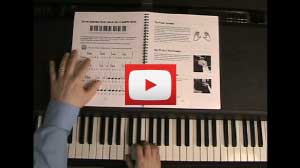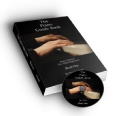Jazz Piano
On this page and its related pages we will introduce you to jazz piano. Jazz music has some elements that separate it from other styles of music. Like the classical musician, the jazz musician needs to have strong technical skills, and a thorough understanding of music theory. What sets the jazz musician apart is the need for excellent improvisational skills in melody and harmony; plus the ability to "swing."
The element of improvisation in jazz piano gives the pianist a sense of freedom of expression not found with other styles of music. Though the pianist must know "the rules," those rules can be broken in an artistic and creative way. How the jazz pianist applies or breaks those rules becomes part of their own personal style.
Like all great art, it takes years of study and practice to develop a style. The professional jazz pianist is expected to know the styles and techniques developed through the history of jazz. Here we will give an overview of jazz piano for the novice, including a brief history, and some basic jazz piano techniques.
Early Jazz
Piano has been an important part of jazz music since its beginning in the 1890's. Before jazz became widespread, Ragtime enjoyed popularity as one of the first music crazes of the modern era. Ragtime was a notated, syncopated music, written primarily for piano.
At the time, the piano was the one of the most popular forms of entertainment in the U.S. This was before radio, and widespread use of electricity. The phonograph was just starting to catch on. Piano sales were at their peak in the early days of the 20th century, and there were more than 100 piano manufacturers in the U.S. alone. The ragtime craze helped to fuel the sales of pianos, especially in the North.
Scott Joplin is the most famous ragtime pianist, and his desire was to be remembered as a composer. His wish is granted, as he is best known for "The Entertainer," a piece of music that most everyone knows.
New Orleans/Storyville
Jazz developed as various styles of African-American music mixed and mingled in New Orleans in the first decades of the 20th century. Blues, spirituals, ragtime, band music, and European music melted together to form what is called America's first genuine original art form. What separates Ragtime from jazz is the fact that jazz is not notated, and ragtime doesn't "swing".
Storyville was an area of New Orleans where many bars, brothels and other houses of disrepute were located. To keep their customers happy, these places employed musicians, who performed this new, exciting and evolving music. Some places had small bands, but many would just have a solo pianist. As World War I broke out, the U.S. Army saw Storyville as a threat to the health of or soldiers, and closed it down. This sent many of those musicians looking for work elsewhere, heading North to Chicago, New York, Kansas City, and other places. This started the spread of jazz.
One of the most famous (and infamous) pianists from this early jazz era was Ferd "Jelly Roll" Morton, who claimed to have "invented" jazz and jazz piano.
This early jazz is commonly known today as "Dixieland." As it migrated to other cities, it began to evolve.
Learn more about Early Jazz Pianists: Scott Joplin and Jelly Roll Morton
Stride Piano
In the 20's, a new jazz piano style started to emerge. Stride had the bass/chord left hand pattern of ragtime, but the swing of jazz in the right hand. The pianist performed all the elements of a band: the rhythm, the bass, the chords and the melody, usually at a frenzied pace.
The style evolved from the solo pianist's need to keep the party going. Often pianists were the entertainment at "rent parties," house parties where the hosts charged admission, or for the drinks. This was during Prohibition, so legally there were no bars for people to go to drink, and hear musicians perform.
Stride was essentially a solo piano jazz form, but some pianists used stride in a group setting. Some of the best known stride players were James P. Johnson, Willie "The Lion" Smith, andFats Waller.
More about the Stride Piano Masters: James P. Johnson, Willie "The Lion" Smith, Fats Waller
Swing
The word "swing" in jazz refers to two things: a style of music, and a way of playing eighth notes. Swing eighths are played "long-short" with a triplet feel. Most jazz used swing eighth notes exclusively until the late 50's, but swing music is generally a type of dance-band jazz performed by large ensembles playing written arrangements.
In the swing era, which lasted from the twenties into the forties, the pianist in a swing band played a chordal support role to the horn arrangement. Sometimes the pianist played only sporadically and sparsely, adding an extra "frill" on top of the arrangement. Count Basie, who could play stride with the best, would play lightly and sparsely in his orchestra. Duke Ellingtonalso would approach the piano in this way. Like Duke, many pianists of the swing era also arranged for the bands. Many of these bands were large, up to 18 pieces. At the time, swing was the most popular music in America.
Along with Duke Ellington and Count Basie, other swing era pianists include Earl Hines, Teddy Wilson and Art Tatum.
Be-Bop
The Be-Bop era evolved as a reaction to the tightly controlled arranged sound of the swing bands. Be-bop was not about the dancers, either. This new music was about the musical exploration of the musicians. The bands were smaller, with one or two horns. There was a major change in the evolution of jazz piano. The pianist didn't have to keep playing a steady rhythmic beat, but could now "imply" the rhythm and harmony using only parts of the chords. The melodies became more angular, and were not like the "singable" melodies of the swing era. This music was a product of New York City, based in the clubs on 52nd St.
Though alto saxophonist Charlie Parker ("Bird") and trumpeter "Dizzy" Gillespie are the "godfathers" of bop, pianists such as Thelonious Monk, Bud Powell, and Hank Jones also played a great role.
More about Be Bop Pianists: Thelonious Monk, Bud Powell, Hank Jones
Hard Bop
In the mid fifties, the music evolved again. The blues was taking a larger role again, and standards were back in favor. The pianists could use all of the techniques in jazz to develop a style, including elements of stride, swing blues and gospel. The harmonic and melodic palette was expanding, with less emphasis on the steady eighth note drive of the bop era, and more "singable" melodies. Straight eighth note grooves with a Latin feel were being used in the jazz band setting.
Some greats of jazz piano in the "Hard Bop" era include Horace Silver, Wynton Kelly, Bobby Timmons, Red Garland, and Tommy Flanagan.
Post-Bop to Contemporary
Since the early 60's, jazz piano has taken on many facets. Jazz has become wide open to interpretation, and the jazz pianist can look in many directions for inspiration. From the huge, powerful crashing chords of McCoy Tyner, to the soft introspective close chording of Bill Evans. From the funky grooves of Herbie Hancock to the sophisticated two handed technique of George Shearing. From the intellectual rhythmic approach of Dave Brubeck to the free explorations of Keith Jarrett.
And then there's the guy who does it all, Oscar Peterson.
Latin jazz has been growing as a major influence, and today's jazz piano player needs to have some understanding of how to play in the style. Some greats in Latin jazz piano includeGonzalo Rubalcaba, Michel Camillo, Monty Alexander, Eliane Elias and Chucho Valdez.
More about Latin Jazz Pianists
Contemporary jazz is music with many flavors and directions. Chick Corea's classical and Latin inspirations influenced almost everyone who followed. Some of today's jazz piano greats include Henry Butler, Geri Allen, Cyrus Chestnut, Benny Green, Marcus Roberts, Bill Charlap, Harry Connick, Jr., Diana Krall and Brad Melhdau.
More about Contemporary Jazz Pianists
Start Playing Piano Today with the Piano Guide Quick Start Course!
Easy to follow step-by-step lessons designed for adult beginners. The next best thing to private lessons!
What You'll Learn:
- Notes on the piano/keyboard
- Proper fingering
- C major scale
- Chords
- How to read music
- And much more!

Video lessons - watch as I play everything for you.

